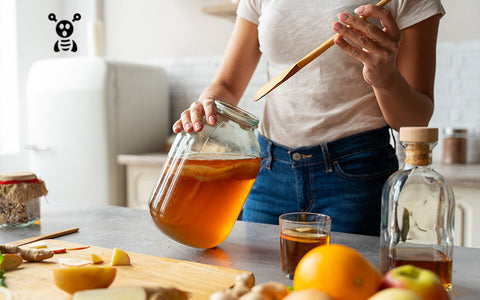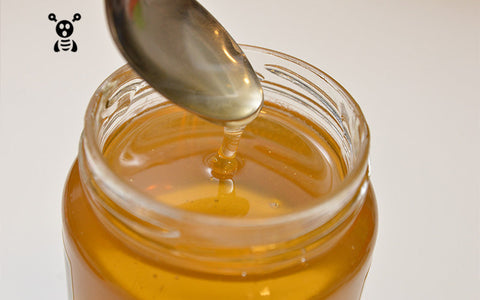From the gently floral sweetness of wildflower blends to the nutrient-rich intensity of raw honey, the world of honey offers far more than meets the eye. But beyond these everyday sweeteners lies something altogether different—mad honey, a rare and powerful wellness product with origins high in the Himalayan cliffs of Nepal.
In this article, we’ll provide a comprehensive breakdown of wildflower honey vs. raw honey, as well as introduce the untamed world of Himalayan mad honey.
Key Takeaways• Understanding wildflower honey vs. raw honey helps clarify that the two aren’t mutually exclusive. • Raw honey undergoes little to no processing, helping it retain key compounds like enzymes, plant-based antioxidants, and small amounts of vitamins and minerals. • Wildflower honey is defined by its floral origin, offering a diverse and seasonally changing flavor profile. • Mad honey is harvested from Himalayan rhododendron flowers and contains grayanotoxins, giving it unique psychoactive effects. |
Wildflower Honey vs. Raw Honey: Key Differences

Before diving into the world of mad honey, it’s helpful to understand the key differences between two of the most popular types of honey: raw honey and wildflower honey. Here’s what sets them apart.
What Exactly Is Raw Honey?
Raw honey refers to how the honey is processed—or more accurately, how it isn’t processed. It’s harvested directly from the beehive and typically strained or lightly filtered to remove impurities like beeswax or debris. Unlike supermarket varieties, it’s never pasteurized, meaning it retains:
• Live enzymes like glucose oxidase, which help with antibacterial activity
• Natural pollen that contributes to its cloudy appearance
• Trace compounds such as propolis, which are linked to immune support
It’s important to note that raw honey can be monofloral (from one plant source, like manuka or acacia) or multifloral (from a variety of plants, including wildflowers). What defines raw honey isn’t where the nectar comes from, but the fact that the honey remains as close to its natural state as possible.
Understanding Wildflower Honey

Where raw honey is defined by its processing method, wildflower honey is defined by its nectar source.
Wildflower honey is made by bees that forage on an abundance of wild-growing plants and flowers. These can include native blooms, flowering herbs, shrubs, and even tree blossoms, depending on the region and season.
This makes wildflower honey:
• Multifloral: It's a blend of nectar from dozens or even hundreds of plant species, which creates a complex and layered taste.
• Seasonally unique: Wildflower honey harvested in spring often has a milder flavor and a paler appearance. Autumn varieties tend to be richer, darker, and more full-bodied.
• Inherently variable: No two batches will ever taste quite the same. Even jars from the same producer may differ slightly in hue, aroma, or texture from one harvest to the next.
Wildflower honey refers to the nectar source, while raw honey refers to how it’s processed. This distinction is crucial when distinguishing between wildflower honey and raw honey, as they describe separate qualities.
Comparing the Taste, Texture, and Benefits of Wildflower Honey vs. Raw Honey
To fully appreciate the differences between these two popular honey varieties, it’s helpful to examine how they compare in terms of sensory qualities, nutritional value, and how they’re used in everyday life.
1. Taste
Raw honey tends to have a bold, earthy flavor profile. Because it’s minimally filtered and retains natural enzymes and pollen, its taste can be deeper and more complex, sometimes with herbal or woody undertones, depending on the nectar source.
Wildflower honey offers a more unpredictable flavor spectrum. While seasonal differences still play a role—lighter in spring, richer in autumn—the real appeal lies in its floral complexity. The blend of various nectar sources results in a complex, aromatic sweetness that’s dynamic and constantly evolving.
2. Texture
Raw honey is typically thicker and may appear cloudy or creamy due to the presence of pollen, wax particles, and enzymes. It also tends to crystallize faster than processed honey, forming a smooth, spreadable consistency over time.
On the other hand, the texture of wildflower honey depends largely on how it’s handled after harvesting. When raw, it behaves like other unprocessed honeys and crystallizes naturally. If it’s pasteurized, however, it stays runnier and clearer for longer, with fewer particulates.
3. Wellness Benefits
Both honeys are considered beneficial for overall wellness, but their value differs slightly based on what you're looking for.
• Raw honey retains its full nutritional and enzymatic profile. It’s rich in antioxidants, antibacterial compounds, and trace minerals. Many use it to soothe sore throats, support gut health, or as a natural energy source.
• Wildflower honey may offer broader exposure to different types of pollen, which could help support seasonal allergy tolerance, especially if sourced locally.
In a comparison of the different types of natural honey, raw honey usually has the edge when it comes to preserving beneficial properties. However, wildflower honey provides diversity and complexity that some consumers value more for taste and allergen exposure.
Where Does Mad Honey Fit In?
While both raw honey and wildflower honey are cherished for their taste and health benefits, mad honey takes you beyond the familiar and into something far more uncommon. It’s not just about flavor but also the unique experiences that this honey can provide. So, what exactly is mad honey?
A Brief Overview of Mad Honey

Harvested from the steep cliffs of the Himalayas, mad honey is produced by the Apis dorsata laboriosa, the world’s largest honeybee. These giant bees forage almost exclusively on the vibrant red flowers of Himalayan rhododendrons, which naturally contain grayanotoxins—neuroactive compounds that create the psychoactive effects mad honey is known for.
The Psychoactive Effects of Mad Honey
In small, controlled doses, mad honey may produce a range of mind-body sensations, including:
• A warming or tingling feeling throughout the body
• Light-headedness or mild euphoria
• A deep sense of relaxation or even dreamlike states
These effects are temporary and generally considered safe when consumed responsibly. However, higher doses can lead to stronger reactions, like nausea, dizziness, or lowered blood pressure, making it crucial to follow the recommended dosage.
Exploring Their Traditional Roots
For centuries, hallucinogenic honey has held cultural and medicinal significance among local Himalayan communities. It's been used:
• In shamanic rituals and spiritual ceremonies
• As a natural sedative or pain reliever
• To support digestive and cardiovascular health
There are even stories of mad honey being used as a weapon in ancient warfare, where armies would bait their enemies with honey that caused confusion and weakness.
Lab-Tested Potency
Given its powerful effects, mad honey requires more careful sourcing and quality assurance than what’s typically expected from raw or wildflower honey. Purity and potency aren’t just selling points; they’re safety considerations.
Mad honey is not a pantry staple. It’s an intentional, elevated experience meant for rare moments of mindfulness, ritual, or sensory curiosity.

How to Incorporate Raw, Wildflower, and Mad Honey Into Your Routine
Once you understand the differences between wildflower, raw, and mad honey, the next question becomes: how do you actually use them?
Each variety of honey has its own purpose. Whether you’re building daily wellness rituals, experimenting in the kitchen, or exploring deeper states of relaxation, there’s a place for each one. Here’s how to bring them into your lifestyle in meaningful and creative ways.
Raw Honey: The Everyday Elixir
Raw honey is your daily companion for natural wellness. Here are some tips on how you can make it part of your routine:
• Stir a spoonful into warm (not boiling) tea to soothe your throat and support your immune system.
• Add it to your morning smoothie for a subtle energy lift without the sugar crash.
• Drizzle it over overnight oats, chia pudding, or nut butter toast for a nutrient-dense breakfast.
• Incorporate it into skincare rituals—many people swear by raw honey masks for glowing skin.
If you're someone who values clean eating, gut health, and natural remedies, raw honey deserves a permanent spot in your pantry.
Wildflower Honey: The Flavor Chameleon
Wildflower honey is the kitchen creative’s best friend. Whether you’re making brunch for friends or leveling up your salad dressing game, this multi-floral honey brings complexity without overpowering.
• Whisk it into salad dressings with olive oil, mustard, and lemon for a touch of wild sweetness.
• Pair it with cheeses—especially goat cheese or brie—for an easy, elegant appetizer.
• Swirl it over warm pancakes, roasted carrots, or vanilla ice cream for a floral finish.
• Add it to marinades for chicken or tofu, especially when you want a hint of caramelization on the grill.
Thanks to its adaptability, wildflower honey invites experimentation. Plus, raw wildflower honey also retains its natural enzymes and nutrients, making it as functional as it is flavorful.
Mad Honey: The Ritual Experience
Unlike wildflower honey and raw honey, mad honey is meant for intentional, mindful moments rather than daily use.
How to use it:
• Take a small, measured amount (typically 1–2 teaspoons) during periods of rest or reflection, such as journaling, sound baths, or breathwork.
• Try it as part of a digital detox or creative reset. Some users report a heightened sense of calm, mild euphoria, or deeper sensory awareness.
• Use it sparingly—ideally no more than once or twice a week—and avoid combining it with alcohol or medications unless advised by a healthcare professional.
Mad honey isn’t about adding sweetness to your routine. It’s about creating a shift in experience—one that invites a deeper connection with yourself, your surroundings, and a tradition rooted in nature.
Frequently Asked Questions
1. Can wildflower honey also be raw honey?
Yes, wildflower honey can also be raw—these terms refer to different aspects of honey. “Wildflower” describes the nectar source, meaning the bees collected nectar from a variety of wild plants. “Raw” refers to how the honey is processed (or not processed). If wildflower honey hasn’t been pasteurized or heavily filtered, it’s considered a type of raw honey.
2. Can you legally buy and consume mad honey in the U.S.?
Yes, mad honey is legal to purchase and use in the U.S. It is not classified as a controlled substance and falls under general food regulations by the FDA. However, due to its psychoactive properties, it should be consumed responsibly and only sourced from reputable, transparent suppliers.
3. Can I take mad honey with other supplements or medications?
If you're taking medications—especially those related to blood pressure or heart function—it's important to consult your doctor before trying mad honey. The active compound, grayanotoxin, can affect the nervous and cardiovascular systems, potentially interacting with certain prescriptions.
4. What’s the best way to store mad honey?
Store mad honey in a cool, dry place away from direct sunlight and heat. A kitchen cabinet or pantry works well. Avoid refrigeration, as cold temperatures may cause crystallization. While this doesn’t affect its safety, it can change the texture. Make sure the lid is securely closed to prevent moisture exposure and maintain the honey’s strength.
5. How can I tell if mad honey is safe and authentic?
Always purchase mad honey from a source that is transparent about its origins and testing practices. Look for sellers who:
• Source directly from the Himalayan region
• Work with traditional, ethical harvesters
• Provide independent lab testing for grayanotoxin levels and rhododendron pollen content
These factors help ensure you’re getting a product that is both effective and safe to consume.
Conclusion: The Honey Spectrum, Reimagined
Understanding the nuances of wildflower honey vs. raw honey is essential if you're seeking natural wellness and honest flavor. But when you're looking for something beyond—something ancient, rare, and mind-expanding—mad honey delivers a different kind of journey.
At Maddest Mad Honey, we believe that nature’s rarest experiences deserve reverence. That’s why we offer only premium, lab-tested mad honey, harvested from the cliffs of Nepal and shipped straight to your door. Each jar is sourced in small batches from traditional Himalayan beekeepers and tested for potency, purity, and a minimum of 87% rhododendron pollen, ensuring that you’re tasting only the best.
Ready to try it for yourself? Contact us and discover what makes mad honey so maddeningly unforgettable.




